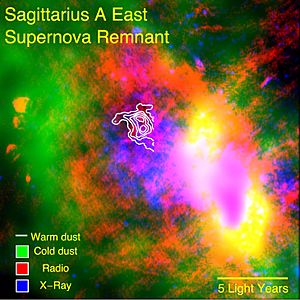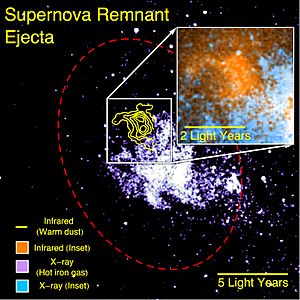Supernova remnant facts for kids
A supernova remnant (often called an SNR) is what's left behind after a giant star explodes in a huge blast called a supernova. Imagine a cosmic firework! When a star explodes, it throws out a lot of its material into space. This material then crashes into the gas and dust already floating around in space, creating a big, expanding bubble.
There are two main ways a star can explode into a supernova:
- A very big star might run out of fuel. When this happens, it can't create energy anymore and collapses under its own gravity. This collapse can form a super-dense neutron star or even a black hole.
- A smaller, very dense star called a white dwarf might pull in too much material from a nearby companion star. When it gets too heavy, it explodes in a massive burst of energy.
In both cases, the explosion sends out star material at incredibly high speeds – sometimes as fast as 30,000 kilometers per second! That's about 10% the speed of light! These super-fast speeds create a powerful "shock wave" that heats up the gas around it to millions of degrees. This shock wave keeps expanding for hundreds or thousands of years, growing to be many parsecs wide (a parsec is a huge distance in space).
Some famous supernova remnants include:
- The Crab Nebula, which was formed by a supernova seen in the year 1054.
- Tycho's Supernova Remnant, from an explosion seen in 1572 by Tycho Brahe.
- Kepler's Supernova Remnant, from an explosion seen in 1604 by Johannes Kepler.
- SN 1987A, a supernova observed in 1987 in a nearby galaxy called the Large Magellanic Cloud.
- The youngest known remnant in our own galaxy, the Milky Way, is called G1.9+0.3.
Contents
How Supernova Remnants Grow
A supernova remnant goes through several stages as it expands and changes over time:
- Stage 1: Free Expansion
* Right after the explosion, the star's material shoots out freely. It's like a fast-moving cloud. * This stage lasts for tens to a few hundred years. * It continues until the expanding material has swept up as much gas as its own weight from the space around it.
- Stage 2: Sweeping Up Gas
* The remnant starts pushing a shell of gas and dust in front of it, like a cosmic snowplow. * This is called the Sedov-Taylor phase. * During this time, the strong shock waves and hot gas glow brightly in X-rays.
- Stage 3: Cooling Shell
* The outer shell of the remnant starts to cool down. * It becomes a thin, dense shell surrounding a very hot center (still millions of degrees). * You can often see this shell glowing in visible light from gases like hydrogen and oxygen.
- Stage 4: Cooling Interior
* Eventually, the hot gas inside the remnant also starts to cool. * The dense outer shell keeps expanding because of its own speed. * Scientists can observe this stage using radio waves from neutral hydrogen atoms.
- Stage 5: Blending In
* After about 30,000 years, the supernova remnant slows down a lot. * It eventually blends into the normal gas and dust of space. * Its remaining energy adds to the general movement and turbulence in the interstellar medium.
Different Kinds of Supernova Remnants
Scientists group supernova remnants into three main types based on how they look and what they contain:
- Shell-like: These look like a hollow shell or bubble, like Cassiopeia A.
- Composite: These have a shell, but also a bright center powered by a fast-spinning neutron star called a pulsar. The pulsar creates a "pulsar wind nebula" inside the shell. Examples include G11.2-0.3.
- Mixed-morphology: These are a bit confusing! They have a shell that glows in radio waves, but their center glows brightly in X-rays. The X-rays come from heated gas that the remnant has swept up. Sometimes, these can also contain a pulsar, making them a mix of types.
Some remnants are so powerful that scientists think they came from even bigger explosions called hypernovas. These are like super-supernovas!
Where Cosmic Rays Come From
Scientists believe that supernova remnants are a major source of cosmic rays in our galaxy. Cosmic rays are tiny, super-fast particles that zoom through space.
- In 1934, scientists Walter Baade and Fritz Zwicky first suggested a link between cosmic rays and supernovas.
- Later, in 1964, Vitaly Ginzburg and Sergei Syrovatskii proposed that if supernova remnants are about 10% efficient at making cosmic rays, they could explain all the cosmic rays we see in the Milky Way.
This idea is supported by something called "shock wave acceleration." Imagine a powerful shock wave moving through space. Particles can repeatedly cross this shock wave, gaining more and more energy each time, like a ping-pong ball bouncing between two paddles that are getting closer. This process can give particles huge amounts of energy.
Supernova remnants provide the strong shock waves needed for this to happen. Observations of the SN 1006 remnant, for example, show signs that it is creating cosmic rays. However, for the very highest energy cosmic rays, scientists think a different process might be needed, as supernova remnants might not be powerful enough on their own.
Scientists are still studying this, and future telescopes like the CTA will help us learn more about how supernova remnants create these energetic particles.
See also
- List of supernova remnants
- Local Bubble
- Nova remnant
- Planetary nebula
- Sigma-D relation
- Superbubble



